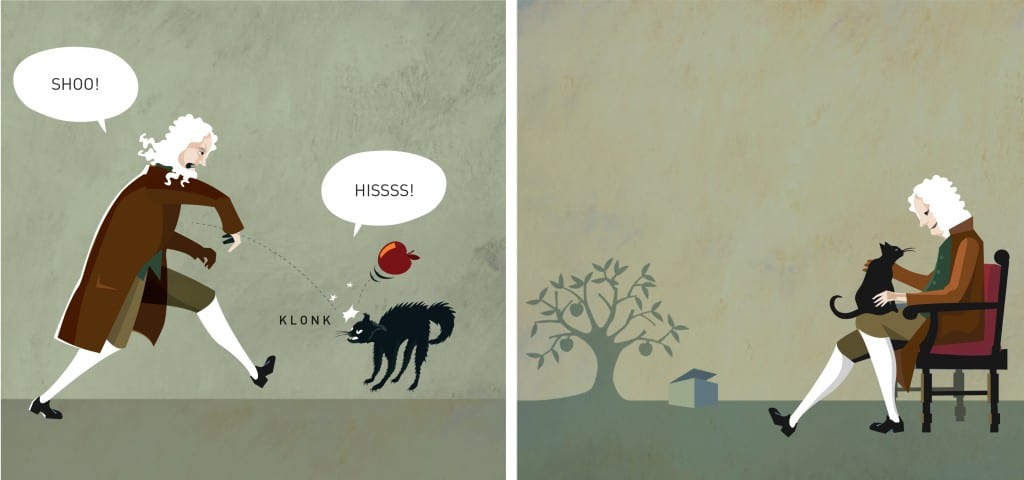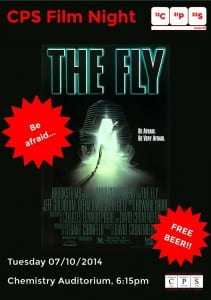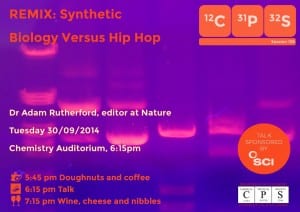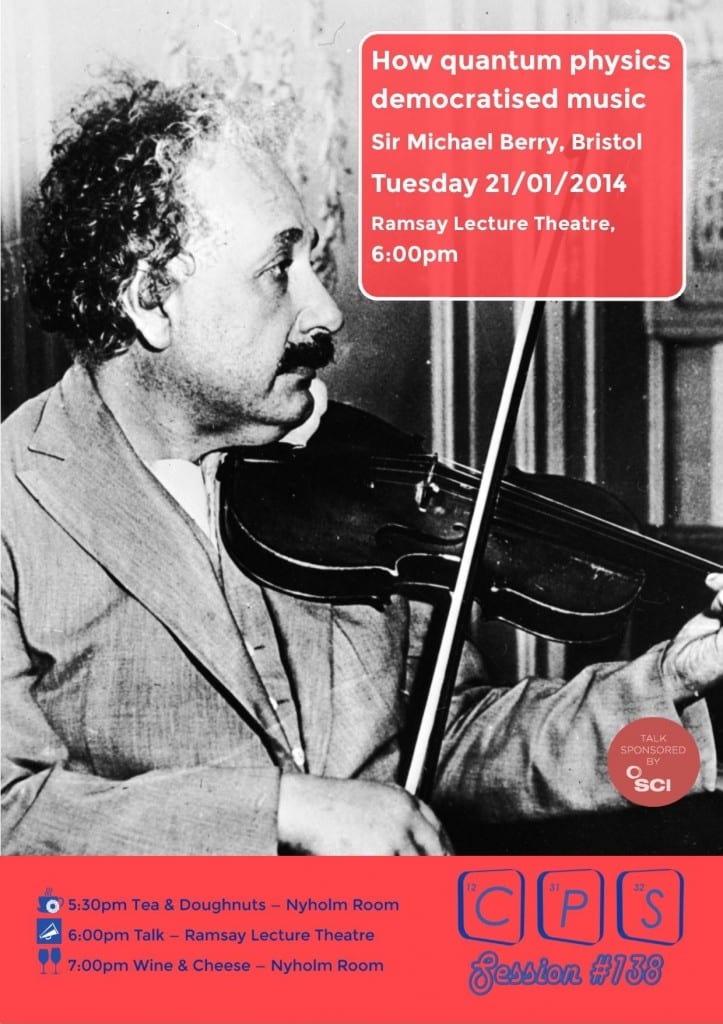Careless Scientist Turns Into Fly: CPS Talk 07/10/14
By Penny Carmichael, on 14 October 2014
-Article by Stephen Leach
This week there was no CPS lecture. Instead, entertainment came in the form of ‘The Fly’ by David Cronenberg. It’s a 1986 sci-fi horror masterpiece in which Mr Cronenberg charts the epic destruction of a brilliant scientist played by Jeff Goldblum who became perilously entangled with the common fly. This film explores how the initial improvements which accompany a scientific breakthrough are followed by dangerous uncontrollable consequences. Much like the martyred Miles Dyson, the computer scientist who created the circuitry that would go on to become the twisted brain of ‘The Terminator’. In the Terminator franchise, robots became so advanced and clever that they wanted to destroy the foolish humans who created them, (all time travelling paradoxes aside).
Yes these technologies are make believe and are accepted for dramatic effect. However the underlying theme has some reality. There is probably a quote from Jurassic Park which could sum up everything I’m getting at here but that would be too simple.
The question is: do science researchers inherit a greater amount of moral responsibility during their training than they sign on for? The film industry certainly says ‘yes’. The mass media says ‘yes’. Scientific findings are reported to the general public via news agencies with minimal reference to any of the assumptions made or experimental context. Once in the news, those findings from a controlled environment go on to directly influence people!
History also agrees in one very extreme case, which is depicted in a 1980 documentary by Jon Else, ‘The Day After Trinity’. Freely available online, it features a collection of interviews with people who had worked on the Manhattan Project or knew J. Robert Oppenheimer. Fifty years on from Hiroshima 1967 Nobel physics prize winner Hans Bethe, head of the Los Alamos Theoretical Division remarked “Individual scientists can aid nuclear disarmament by withholding their skills…” Even to discuss the weapon they created is to enter into a sticky moral debate.
As a chemistry undergraduate the closest I get to a moral issue is the use of excessive amounts of water in the teaching labs, or by accidentally misusing the waste recycling facilities around campus, (thankfully the chemistry department is addressing the former and I’m paying closer attention to the bins). Most people, researchers or otherwise will get through careers and life without becoming embroiled in any serious moral dilemmas. Is that due to a lack of them? Or due to a haziness around accountability and how empowered or disempowered we feel when faced with one? You only have to enter a supermarket to be faced with an ethical decision and discover that our system allows the ‘ethically sound’ shopping basket to cost more than its battery farmed equivalent. Stop giving me the choice to be morally lazy!
I’m confident that the majority of students embarking on scientific educations are striving to make the world a better place and trust in the academics we’ve encountered here at UCL to help us do so. Scientific research does transform society for the better. The more scientists delve into non quantitative moral issues, the more religious/political leaders cease to be the sole governors of morality.
Personally, I don’t even have the guts to tell someone to pick up their litter. ‘Doing my bit’ for society involves a highly expensive and long education. Thus are the complexities of procrastination.
This blog entry by the film maker Adam Curtis via the BBC has discussed this theme far more coherently than myself (or Jurassic Park), so take a look for some food for thought:
http://www.bbc.co.uk/blogs/adamcurtis/posts/THE-VEGETABLES-OF-TRUTH
He says:
“Science and scientists do all kinds of wonderful things. But when they venture into the social and political world they tend to get bent the way the ideological wind is blowing.”
If scientists are not bent by the ‘ideological wind’, then are they not at risk of ignoring the society which they are meant to serve?
Rhythm and Base Pairs – CPS Talk 30/09/14
By Penny Carmichael, on 6 October 2014
– Article by Stephen Leach
In the first of the weekly CPS talks this year, Dr Adam Rutherford visited the UCL Chemistry Department to discuss the unlikely companions of genetics and hip hop. As a conscientious biologist and geneticist he opened with a cautionary tale about incest. The Habsburg Dynasty of Spain (who ruled Spain between 1516 and 1700) had a family tree resembling more of a family web. ‘The Habsburg Jaw’ was their treasured facial feature and for this distinctive chin they risked the fertility and health of their descendants, inevitably ending their reign. Charles II, the last Habsburg, died heirless at 38; his jaw couldn’t save him. Genetics is hinged on the relation between the genotype (the genetic material) and the phenotype (the physical result of the expression of the gene). Hence the Habsburg Jaw is the phenotype for the expression of one or many genes which had been intimately shared around the family. In their defence, Dr Rutherford concluded the tale by reminding us that nobody is perfectly outbred.
Once this connection had been made, the curious scientist wondered about the possible transfer of genetic material between organisms in order to control novel unnaturally occurring characteristics. This is not a new idea; The Chimera, (a hybrid animal which is composed from parts of others) was originally found in Greek mythology and is often used in heraldry. ‘The Enfield’ for example, a chimera with the head of a fox, the body of a lion, an eagle’s talons and the ass of a wolf appaears in the London Borough of Enfield’s coat of arms. Human-like chimeras are found in H.G. Wells’ 1896 novel ‘The Island of Dr. Moreau’, which questions of how far science should interfere with nature, although it was vivisection at the time which had inspired its plot.
When Darwin wrote “The Origin of Species”, he chose to tread fairly carefully; he personally didn’t want to initiate a full renegotiation of the prevalent religious doctrine of the times. Hence the book opens with a chapter on Pigeon Fanciers, entitled “Variation Under Domestication” and presents incredibly lucid argument for his theory in the context of the controlled breeding of pigeons, which was at the time ubiquitous. The breeders select the phenotype they wish to preserve and allow that individual to breed; unnatural selection. If the phenotype was being preserved, then so must the genotype.
In nature, genetic material can be mixed by breeding or by the mechanisms of viruses, but in the modern laboratory genetic material can be shared with much greater control. Examples were given of some amazing current technologies: a plant which has been genetically modified to grow purple instead of green when in the presence of land mines. Yeast cultures which secrete diesel. Genetic logic based circuits which ‘calculate’ whether a cell is cancerous and if so, instruct it to kill itself.1
Finally that brings us to the hip hop analogy which serves to illustrate the idea that the progress/development/evolution of ‘a thing’ is propagated by the sharing or transfer of material. This analogy takes flight upon the recognition that early hip hop was built on samples, that is, pre-recorded music from another artist re-expressed in a new context resulting in a novel characteristic sound. The reorganisation of material had enlivened and enriched the final product, making it ‘fitter’ than its competitors. The creators of the chimera were DJ’s of the dark ages, mixing not beats but beasts. Darwin’s pigeon fanciers are like music producers, tuning and honing not the beats but the beaks and breasts.
As for the modern examples, the analogy changed. Genetic research brings with it ethical problems, while at the apex of hip hop were legal problems. In order for hip hop to become the hugely lucrative enterprise it now is, there had to come a restriction on the sharing of material, ownership and licensing were ushered in; survival of the richest. Dr Rutherford suggested that this meant the end of the genre, having lost its mechanism to freely exchange material. Although perhaps ‘speciation’ had taken place and the genre has not died, but changed its habitat. A similar struggle occurred in the biosciences as companies attempted to become legal owners of genetic material. Thankfully this has yet to occur. In genetics and hip hop such restriction could be considered stifling.
Dr Rutherford’s favourite rapper is Tupac Shakur, that’s an exclusive. However he chose to conclude with a quote from the American activist and Professor of Law; Lawrence Lessig:
“A culture free to borrow and build on the past is culturally richer than a controlled one.”
References:
- See Xie et al. 2011 ‘Multi-input RNAi Based Logic Circuit for Identification of Specific Cancer Cells’
Diamonds are a Chemist’s Best Friend – CPS Talk 04/02/14
By Penny Carmichael, on 21 February 2014
– Article by Jack Humphrey
UCL’s own Professor Paul McMillan takes us on a journey to the centre of the earth in search of the weird and wonderful chemistry that occurs at high temperatures and pressure with a smattering of biology too.
Chemist Wins Public Engagement Award for SuperLAB! Event
By Penny Carmichael, on 13 February 2014
-Article by Clair Chew
Walking into a Shoreditch bar on a Wednesday evening, the last thing you might be expecting is a CSI crime scene and lab ready for you to play detective. The free ‘SuperLAB!’ events were inspired by crime and superhero comics and ran over the course of two nights. Artists and scientists came together to organise activities and discussions for punters at the bar. On the first night, ‘Draw’, artists, psychologists and neurologists demonstrated the art of comic books, how art has come to influence science, investigate what makes a person have the ‘right’ brain for art and whether chemicals can expand the creativity of artists. ‘Crime’, the theme of the second night saw psychologists and scientists focusing on how the crime was performed, what makes a devious villain and most importantly, the modern forensic techniques used to catch them!
One half of the SuperLAB! bid team, Nadia Abdul Karim, has recently won the ‘Student Engager of the Year’ at the Provost’s ‘Public Engagement Awards’. During a break of unnecessary email checking at work, Nadia had decided to respond to an ad about the project. One thing led to another and she managed to successfully co-bid for a grant to fund the two evenings. As someone who has organised a few smaller events, I can appreciate the time and hard work that Nadia had put into not just the demonstrations, but also sourcing equipment and managing students for such an ambitious event.

Nadia Karim (right) receiving the ‘Student Engager of the Year’ award from the Provost (centre). Congratulations Nadia!
Like most PhD students, Nadia is fuelled by a desire of answering questions of how’s and why’s. After completing a Forensic Science undergraduate degree, she decided to join UCL’s Crime and Security Science DTC program looking at explosives. Explosions might sound exciting but the slog of research can take its toll on even the most vivacious of students, losing sight of how and why we are doing a PhD. Research students experience this everywhere after looking at, as Nadia puts it “an endless list of negative results”. She is optimistic however, enthusing that engaging with the public can be powerful fuel, “it helps you realise that research goes beyond the lab and office, and it does affect and interest the wider public.”
The award of student engager wasn’t just received for the coordination of the ‘SuperLAB!’ event Nadia also participates in one-off events such as outreach at schools, open days at the Institute of Making and public taster lectures. She has also taken on roles of being a student and ‘Brilliant Club’ mentor. Even just thinking about this many commitments has made my head spin; I had to ask Nadia how she does it. It turns out she is just a ‘Yes’ girl; “I sign up to doing all of these things, then realise I have a ton of university work to do at the same time and then somehow manage to be super-efficient (usually with the help of caffeine) to get everything done”.
Showing signs of self-deprecation, Nadia admits to not having any great planning or time management skills, just being an effective worker under pressure. Perhaps it is more than just organisational skills, thinking back to one my first encounters with Nadia at a dinner, she strikes me as having a genuine interest in society and people. Combining her sense of social responsibility with a scientist’s curiosity certainly makes Nadia an ideal, exciting and valued science communicator.
Only Connect – CPS Talk 21/01/14
By Penny Carmichael, on 12 February 2014
– Article by Jack Humphrey
“Physics is like sex: sure, it may give some practical results, but that’s not why we do it”
Chemists Go Green
By Penny Carmichael, on 15 January 2014
– Article by Mark Fields
In the UK a new initiative has been set up with the aim of accrediting departments in universities on their environmental impact. This scheme is called the Green Impact Scheme and it aims to encourage progress and good environmental citizenship within university education. There is nothing quite like competition to encourage progress (and this scheme does just that) by setting up inter-departmental competitions within universities. The currency is a range of awards, for action plans which improve the environmental impact of each department and these are banked using an online workbook. Furthermore, to stoke participant’s creativity, special awards are given for unique projects which have been implemented as opposed to those which are already in the workbook. These unique projects encourage the discipline of each department to flourish and be shown be translated in the green impact work. For example, a biology department planting a wildlife garden (fat chance of that in central London where a square meter costs an arm and a leg). The scheme at UCL is run by the sustainability department. In the spring of next year, ambassadors for the department assess the implementation of the awards proffered in the workbook by each green impact group, and then the results of the Green Impact competition winners are announced.
The chemistry department of UCL has a Green Impact team which grows in numbers every week and consists of research students, staff and undergraduates. This team is a true representation of the departmental demographics, and so the effects are far-reaching. Weekly meetings take place in the Nyholm room on Thursdays between 1 and 2pm, where this team plots and plans to tackle the latest green issues in the department of chemistry.
The last two years have seen the department for Civil Environmental and Geomatic engineering take the winning spot within UCL. Of course, this discipline is implicit in positive environmental impact, but, no less so than the discipline of chemistry. Environmental chemistry, for example, is a field of chemistry in its own right, responsible for the discovery of DDT and CFC’s, detrimental substances which are now banned. James Lovelock, one of the leaders in the field of climate-change science, and founder of the Gaia theory, was a chemist himself; so, chemists are vitally important in environmental impact projects and hence great contenders in this competition. Green Impact actions we instigate could even lead to pilot schemes which become universal. Indeed, a project which bring’s more improved and more environmentally printing has already commenced in the department. For an even greater impact, we should seize this opportunity to start disseminating our chemical wisdom and start to lead climate change action by example. This is the long-term aspect to this scheme. Most importantly, we aim to cause a modest revolution in the way that we perform chemical research and teaching on a day-to-day basis, and who knows, maybe one day there will be a roof-top garden/ laboratory.
To find out more:
Visit the UCL Green Impact Site
Keep updated on our Blog
And to get involved, e-mails to the author: mark.fields.11@ucl.ac.uk
What’s you green resolution? Here are some from the UCL community, including our very own Prof. Andrea Sella, research fellow Dr. Charlie Dunnill and PhD student Pragna Kiri.
Chemistry Christmas Squash
By Penny Carmichael, on 10 January 2014
-Article by Marion Brooks-Bartlett
Following the chemistry summer fun of the last squash tournament organised for computational and physical chemists, we extended the invitation to the whole range of staff and postgraduate chemists for Christmas. The setup of the tournament included a mini league and ending with knock-out rounds getting everyone fit and tired with so many games to play. This time the legendary squash-playing Prof Graeme Hogarth participated and easily obtained the gold. All this during his last week at UCL after 25 years! Good luck Graeme! This tournament marks the beginning of a chemistry squash league to start next year, when is still to be confirmed, but remember this is open to everyone- skilled and beginners, male and female, organic to physical and will hopefully be a league to continue for many years. So get involved!
– You can shed a few of those Christmas pounds by participating in the UCL Chemistry squash ‘ladder‘. All levels of playing ability are welcome. Contact Marion for login details.
Bones of Contention – CPS Talk 12/11/13
By Penny Carmichael, on 2 December 2013
-Article by Jack Humprey
This week the CPS went on a trip out – but just round the corner. The Grant Museum of Zoology is the only zoological museum in London. We were given a lecture on its history by the curator Mark Carnall.
The collection was intended for medical students as at the time comparative anatomy was part of the medical curriculum. With the advancement of molecular biology, zoology fell out of favour and universities and hospitals began to throw out their collections and they were eagerly accepted by UCL. In 1996 the collection went public as the Grant Museum. The museum moved to its present location in the Rockefeller Building in 2010, the entire move taking 8 months. It regularly holds educational workshops with schools and can be hired out for conferences.
Damn Dirty Apes – CPS talk 05/11/13
By Penny Carmichael, on 20 November 2013
– Article by Jack Humphrey
Professor Jones stressed that evolutionary biology is a comparative science – it works by comparing shared traits between species. But it falls down on understanding things unique to humans such as complex language or cooking as it is very easy to extrapolate conclusions but very difficult to prove them.
Calculated Chemistry: Nobel Prize 2013
By Penny Carmichael, on 8 November 2013
Article by Enrico Berardo

Congratulations to Karplus, Levitt and Warshel (L to R), this year’s recipients of the Nobel Prize in Chemistry
This year’s Nobel Prize in Chemistry was awarded to Martin Karplus, Michael Levitt and Arieh Warshel, who played a crucial role in the development and application of methods for the simulation of complex chemical reactions. The Nobel laureates have been recognized for their effort in developing computer programs that simulate the behaviour of chemical systems at various length scales, from simple molecules to proteins, enabling the study of phenomena such as catalysis, protein folding and drug design.
Originally chemists used to create molecular models using plastic balls and sticks, but since the 1960s the modelling is carried out more and more on computers, allowing the calculation of important molecular properties such as stability and reactivity. Throughout the years, a continuous increase in the computational resources and more efficient algorithms enabled the application of calculations to larger and more realistic systems, such as proteins, drugs and materials. The work of Karplus, Levitt and Warshel, focuses on the development of methods that made Newtonian classical physics work side by side with the inherently different quantum theory. This Nobel Prize not only rewards the lifetime achievements of the three laureates, but it also recognizes the relevance of computational chemistry as a support and explanation for many experimental results.

Newton and Schrödinger’s cat – whoever said that classical physics and quantum chemistry couldn’t get along? Thanks to Karplus, Levitt and Warshel for acting as mediators!
In the classical approach atoms and bonds are approximated as balls and springs, making the calculations easy to solve and allowing the study of very large systems (up to thousands of atoms). However, since electrons are not considered explicitly, this method cannot be used to simulate reactions that cannot be easily parameterized with experimental data. For that purpose, an unbiased quantum mechanical approach needs to be used instead. In this approach electrons are considered explicitly, leading to a very detailed description of chemical processes. Its weakness is that the calculations require enormous computing power, limiting the size of the systems that can be studied.
The ground-breaking work of the three laureates revolutionized the field of computational chemistry, where combining quantum with classical mechanics (“QM/MM”), allowed the study of systems that were not even remotely conceivable before the 1970s. The use of those “hybrid” methods made the study of biomolecules such as enzymes possible, treating the reactive atoms of the molecule (core) with quantum mechanics, while the less demanding classical mechanical approach is used to describe the remaining part of the system.
The work behind this year’s Nobel Prize has been the starting point for further theoretical developments of more realistic models and for applied studies. Nowadays, hybrid methods are not only employed in the study of molecules of biological interest or complex organic reactions, but also for the optimization of solar cells or the study of materials used for catalytical applications.
Computational chemistry at UCL is represented by a grouping of international strength characterized by successful academic and industrial collaborations. It accounts for up to twenty different research groups where, thanks to the UCL and UK national computational resources, a breadth of different topics and methodologies are investigated. UCL’s computational chemistry has a strong tradition on the simulation of materials where Prof. Catlow’s, Prof. de Leeuw’s and Prof. Michaelides’ extended groups focus mainly on the study of catalytical applications of metal and metal oxides systems. Prof. Kaltsoyannis’ group employs quantum chemical investigations on actinide and lanthanide systems, with the focus on nuclear waste materials. Members of Prof. Price’s group investigate the thermodynamic stability of organic crystal polymorphs through the use of a classical mechanical approach. In the groups of Prof. Coveney and Prof. Gervasio large scale computational methods are developed and used for the modelling of systems like complex fluids, and molecules of biological interests.
Today simulations became so powerful that such a large variety of topics and methodologies can be employed to predict the outcomes of traditional experiments. However, no simulations will ever be able to predict if a future Nobel Prize winner is hiding in the UCL chemistry corridors. This is for the future to decide.
Further information on the work being carried out by UCL Chemistry’s computational groups can be found here
Sources for text and images:
1) Popular science background
2) Scientific background
3) Interesting annual review by Prof. Martin Karplus
 Close
Close











 Subscribe to this blog!
Subscribe to this blog!